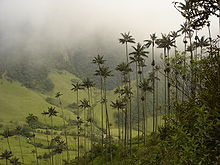- Ceroxylon quindiuense
-
Ceroxylon quindiuense 
Ceroxylon quindiuense growing wild in Cocora valley near Salento, Colombia Conservation status Scientific classification Kingdom: Plantae (unranked): Angiosperms (unranked): Monocots (unranked): Commelinids Order: Arecales Family: Arecaceae Genus: Ceroxylon Species: C. quindiuense Binomial name Ceroxylon quindiuense
(Karsten)Ceroxylon quindiuense (Palma de cera del quindio, Wax palm tree), is a palm native to the Andean high altitude valley of Cocora in the department of Quindío, northwest Colombia.
Contents
Description
The wax palm grows up to 50 m (rarely to 60 m) tall in good growing conditions and is not only the tallest palm but the tallest monocot in the world. The leaves are dark green and grayish, with a petiole up to 2 m long. The trunk is cylindrical, smooth, light colored and covered with wax, When the leaves die they fall and this forms a dark ring around the trunk. The palm is recognized as the national tree of Colombia, and since the implementation of the law 61 of 1985 is legally a protected species. Ceroxylon quindiuense has an extremely slow growth and can live up to a hundred years. It was observed by Alexander von Humboldt, for the first time, in 1801.[1]
Ecology
Wax palms provide habitats for many unique life forms, including endangered species such as the Loro Orejiamarillo (yellow-eared parrot) Ognorhynchus icterotis. It grows in groups spread-out over the hills of the western side of the Andean mountains, between 2.500 - 2.800 meters above sea level. Its habitat is sandy soils with a high acidity, and an average rainfall of 1800 mm/year. It has a required temperature range between 12-19°C.
Threat of extinction
The palm faced extinction due to human action. The wax of the trunk was used to make candles, until the introduction of electricity. The wood of the palm is unsuitable for the timber industry, but was used to build rudimentary water supply systems for poor farmers.[2]The fruits were used as food for cattle and pigs. The leaves were extensively used in the Catholic celebrations of palm sunday.[3] All of these circumstances produced a drastic reduction of the number of wax palms,[4] which motivated the Colombian government of Belisario Betancur to begin providing protection for the remaining trees.
References
- Bernal, M., Navas, A. & Madriñan, S. 2007. Developmental morphology and growth patterns of the wax palm Ceroxylon quindiuense.
- Henderson, A. 1995. Field Guide to the Palms of the Americas.
 National symbols of Colombia
National symbols of ColombiaNational Anthem · Flag · Coat of Arms · Sombrero Vueltiao · Andean Condor · Carriel · Poporo Quimbaya · Wax Palm · May flower Orchid · Chiva Bus
Categories:- IUCN Red List vulnerable species
- Ceroxylon
- Trees of Colombia
- Flora of the Andes
- Conservation in Colombia
- Colombian culture
- National symbols of Colombia
- Endemic flora
- Vulnerable plants
- Endangered plants
Wikimedia Foundation. 2010.


